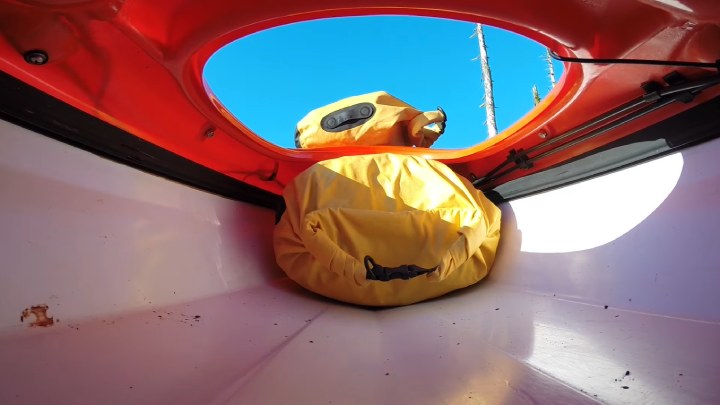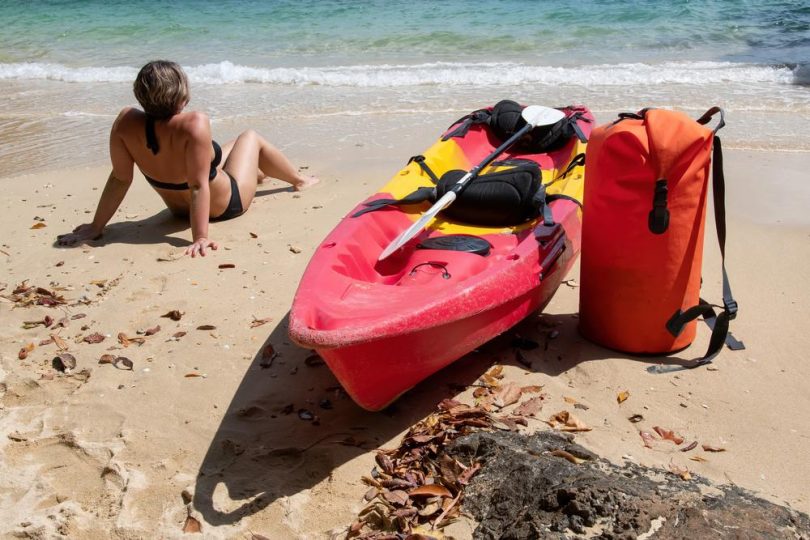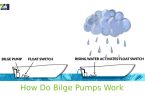Most kayakers use 10L or 20L dry bags. However, there are purpose-built dry bags that can carry anywhere between 2L to 55L, depending on what you intend to carry, how’s the weather, how much can you carry, and more.
Just as you have the option of only carrying your essentials, you can carry your whole tent inside your dry bag if you’re up for it. So, which dry bag size should you try? Well, that’s where we come in.
In this article, we’re going to break down the factors that control how much you need to carry on your kayaking trip. Our intention is to help you choose the right size dry bag regardless of the type of adventure you’re heading into. Let’s jump right in.
Table of Contents
What size dry bag for kayaking
1. 40 liter+ dry bags
Go for 40 liter+ dry bags if you have a reliable way to strap them outside the boat. There is no way to fit them inside the waterproof hatch of your kayak.
These bags have enough capacity to fit gear for two people for multiple-day camping or kayaking trips.
They are substantially heavy to carry so keep them with the kayak when you reach your destination.
Shift your items to smaller backpacks to carry from the kayak to the camping site.
2. 30 liter dry bags
These bags may fit in half of your gear for overnight trips.
Suggested packing for these bags include two changes of clothes, camp pillow, toiletries, jacket and hat, first aid kit, and towel
Another useful combination is jacket, food, and camping tent. Keep your sleeping bag, tent footprint, and camp pillow inside the bag if your plan is to sleep in comfort.
3. 20 liter dry bags
20 liter bags give you enough space to pack bulky items like a jacket, clothes, or a camp pillow.
They have the capacity to contain several days worth of meals or extra clothes along with an extra windbreaker.
4. 10 liter dry bags
Use these bags to carry small gears like camp cookset, camp stove, and some food.
A small jacket or extra shirt, snacks, hat, and toiletries are also easy to carry in them.
5. 5 liter dry bags
Five liter bags are the most favored dry bags to carry non-bulky items.
Items like hats and gloves, first aid kit, and snacks are the best to store in these bags. Cameras, toiletries, camp stoves also fit in them easily.
6. 2 liter dry bags
Store your wallet, keys, phone, snacks, flashlight, and map in two liter bags to use them frequently during the camping.
Things to Consider When Selecting Dry Bag Size for Kayaking

1. Construction
a) Nylon
Nylon-made dry bags use a waterproof coating.
The lightweight bags are easy to pack and the combination with taped seams make them mostly waterproof. Check the fine print for confirmation.
Be cautious with sharp objects so you don’t make a hole through these bags.
b) PVC/Vinyl
PVC/Vinyl bags are the most watertight and durable but weigh the heaviest.
The naturally waterproof material is used to make dry bags of all types and sizes. They come in solid colors but can also be transparent, which helps you keep things organized.
Use a combo of vinyl and lightweight nylon bags to carry heavy items.
c) Air-permeable bag
Some dry bags have an air-permeable base and compression straps.
They are perfect to carry sleeping bags or clothes that you can compress to save room.
There are also dry bags that use the combination of several materials like nylon, PVC, polyester, and TPU.
2. Closure types
a) Top-closure
Most kayaking dry bags have a roll-top closure that effectively seals the content against water ingress.
The closure reliably keeps water out of your dry bags but requires you know the proper protocol of dry bag sealing.
b) Zippered-closure
Other dry bags include a zippered closure that provides easy access to the content.
The effectiveness of this closure type has vastly improved in recent times but you may want to check multiple user reviews before you choose one.
3. Carrying style
a) Tapered bulkhead-style dry bags
Some couples of tapered bulkhead-style dry bags are what you need for long distance kayak outings.
They are especially designed to help maximize the storage space in the bulkhead compartment of your kayak.
The sealing of these bags are similar to backpack-style or sling backpacks but the tapered shape helps avoid negative space inside the compartment.
The only problem with the design is that you need to give a lot of thought to the packing so that you don’t have to go to the bottom to pull out the item you need.
b) Backpack-style dry bags
Get back-style dry bags for multi-day trips on kayak or trips that require carrying your kayak over land for a short distance.
The original design of these bags doesn’t allow for a comfortable carrying but you can walk up to a mile or more with the newest units.
Some of them include a hip belt to provide more support and lift to carry heavy stuff over longer journeys. They also have two straps that go over your shoulders, which isn’t present in sling bags.
c) Sling-style dry bags
These small bags are conveniently small to carry over your shoulders when your kayak lacks the space to store them.
Their sling strap is removable, which gives you the option to carry on the left or right hand. You can leave the strap back at home to keep the bag into the kayak storage with less weight.
d) Duffel-style dry bags
Duffel-style dry bags have the largest capacities among all the dry bag styles.
They seal with zippered closure so you don’t need to remove any content to get the item stored at the bottom.
The bulky dimensions make it hard to fit them into the kayak compartment so you often have to strap them to the deck of “sit on top” kayaks.
Canoers also use these bags since they don’t have fit them inside a sealed storage space.
Tips to pick dry bag size
-
Number of gears
Kayaking gears are easier to pack with more dry bags.
Check how much of all gears you need to keep dry and how you plan to organize them.
You want one dry bag for clothing, one for toiletries, and another for sleeping items.
The problem with the concept is that you will have a hard time strapping so many dry bags onto the kayak.
Fewer, larger dry bags are easier to strap but that makes tracking your gear a harder job.
-
Consider the kayak type and size

Pick larger bags when you go kayaking with a “sit on top” kayak.
Use compact dry bags for sit-in kayaks that have waterproof hatches with small openings.
-
Trip plan
Check if you need to portage or plan to hit some rapids during the trip.
Find out if there’s a chance that your content will end up in the water and pick your dry bags accordingly.
-
Accessories

Check how many internal and external pockets are available to store your phone, keys, or wallet.
Look for bags with mesh pockets if you want specific storage for bottles.
External straps, external loops, D rings, handles etc helps you attach and carry extra items easily.
Pick bags with reflective strips if you want them to be visible in the dark. Bright colors are also easy to find at night.
Which dry bag size should you choose for kayaking?
A combination of dry bags of different sizes is the best option for kayaking.
Pick one or two large size units to carry bulky items.
Store your toiletries, kitchen gear, and other odd items in a couple of smaller bags while you go on trips on the water.








Leave a Comment